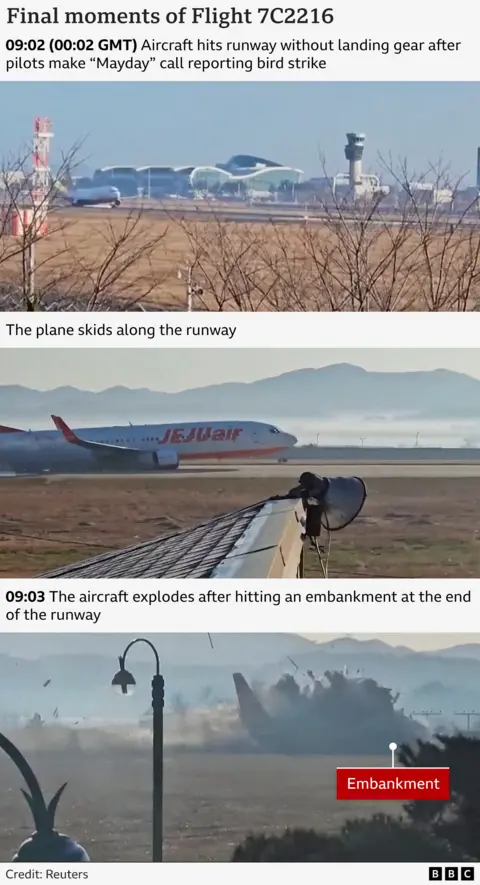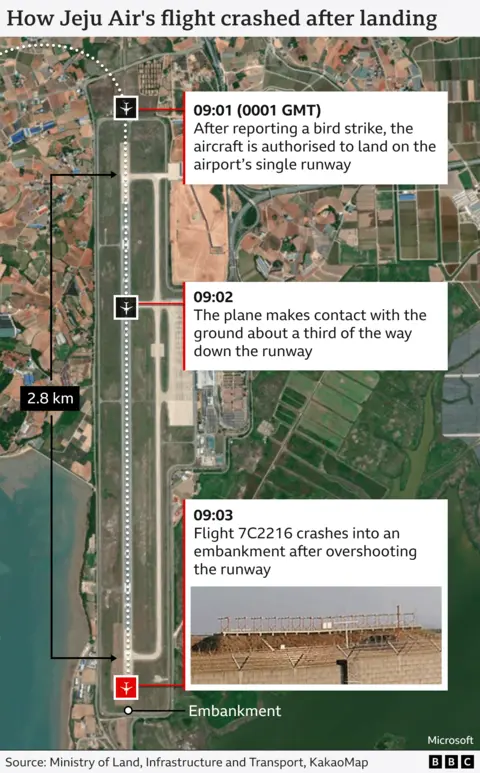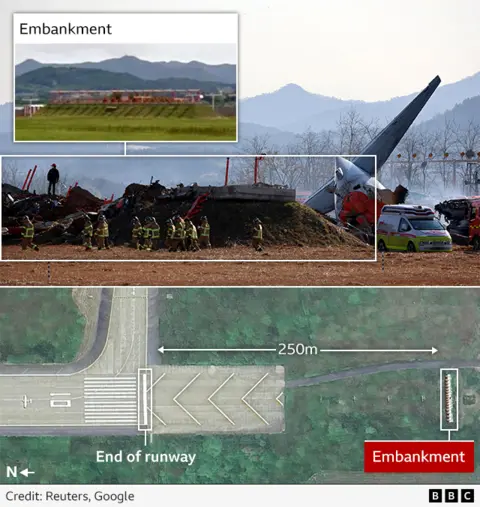 Reuters
ReutersAviation experts have raised questions about an “unusual” concrete wall near the runway and its role in the South Korean plane crash that killed 179 people.
Footage shows the Jeju Air plane skidding off the runway before crashing into a wall and bursting into flames at Muan International Airport.
Authorities investigating the cause of South Korea's worst plane crash have noted the significance of the concrete wall's location about 250 m (820 ft) from the end of the runway.
Air safety expert David Learmount said that if the “obstruction” had not been there, the plane “would have come to rest with most – possibly all – of those on board still alive”.
The pilot reported that the aircraft struck a bird and then aborted the initial landing and requested clearance to land from the opposite direction.
The aircraft descended some distance along the 2,800 meter runway and appeared to land without using its wheels or other landing gear.
Mr Learmount said the landing was “as good as a no-flaps/no-gears touchdown can be: wings level, nose not too high to avoid tail break” and the aircraft suffered no significant damage as it skidded down the runway.
“The reason so many people died was not the landing as such, but the fact that the plane hit a very hard obstacle just beyond the end of the runway,” he said.

Christian Beckert, a Lufthansa pilot based in Munich, called the concrete structure “unusual”, telling Reuters: “Usually at an airport with a runway at the end you don't have a wall.”
The concrete structure houses a navigation system that helps aircraft land – known as a localizer – according to South Korea's Yonhap news agency.
At a height of 4 meters, it is covered with soil and raised to keep the localizer level with the runway to ensure it functions properly, Yonhap reported.
South Korea's transport ministry said other airports in the country and some abroad have equipment installed with concrete structures. However, officials will examine whether it should have been made of lighter materials that would break more easily on impact.
Chris Kingswood, a 48-year-old pilot who flew the same type of aircraft involved in the crash, told BBC News: “Obstacles within a certain range and distance from the runway have to be frangible, meaning that if an aircraft makes an impact , that they break.
“It really seems unusual that it's such a solid thing. The plane, from what I understand, was traveling very fast, landed very far down the runway, so it would have passed well past the end of the runway… so where do you draw the line with that? This will certainly be investigated.
“Airplanes are not rigid structures – they are designed to be lightweight to be efficient in flight. They are not really designed to go at high speed on their bellies, so any structure can cause the fuselage to break and then be catastrophic.

“Fuel is stored in the wings, so once a wing ruptures, the potential for fire is significant.
“So it's not a given that if the wall hadn't been there it would have been a completely different outcome.”
Mr Kingswood said he would be “surprised if the airport does not meet all requirements in line with industry standards”.
“I suspect that if we toured the airports of many major international airports … we would find many obstacles that could similarly be accused of being a hazard,” he added.
Aviation analyst Sally Gethin questioned whether the pilot knew the barrier was there, especially given that the plane was approaching from the opposite direction of the normal landing approach.
She told BBC News: “We need to know if (the pilots) knew there was this hard boundary at the end?
“If they were ordered by the control tower to cancel the use of the runway a second time, that should come to light in the investigation of the black boxes.
“I think there are so many questions.”


